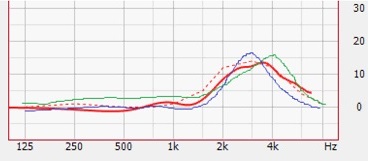Hey yes, i tried that as well and you are right it works much better. Im ordering new capacitors with 100uF so i can use a smaller resistor. Im also ordering some smd inductors from which i know are traditionally not used with BA drivers but i figured its worth a try.
Another Question i wanted to ask is:
Do you guys use a compensation curve for measuring frequency response? There is something called open ear gain which is the natural resonance of the outer ear canal. In short it increases the area around 3khz. If you put a CIEM in your ear this effect wont take place and you need to compansate for that.
Im sure the most of you know this im just explaining because maybe there are a few who don´t know that.
Here is an extract of an wikipeadia article about this topic:
Insertion gain
The traditional method of real ear measurement is known as
insertion gain, which is the difference between the sound pressure level measured near the ear drum with a hearing aid in place, and the sound pressure level measured in the unaided ear. First a measurement is made with the probe tube in the open ear (Real Ear Unaided Response, or REUR), then a second one is made using the same test signal with the hearing aid in place and turned on (Real Ear Aided Response, or REAR). The difference between these two results is the insertion gain. This gain can be matched to targets produced by various prescriptive formula based on the patient's
audiogram or individual hearing loss.
[9]
Another interesting read:
Article
I know a audiogolist who can measure the real ear with an in situ microphone. Wouldn´t it be possible to measure someones ear and take that curve to compansate in ARTA. You could than presumably achieve a more flat/linear response?


























 .
.